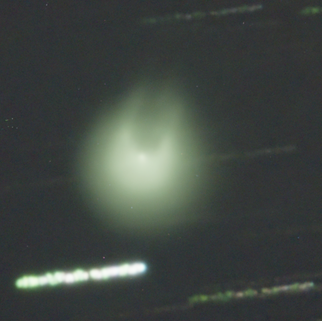After 71 years, Comet 12P/Pons-Brooks has reached magnitude 5, the traditional point where an object is considered to be visible without binoculars or telescopes. You’ll still need particularly fortunate conditions to spot it with eyes alone, however, although even small instruments will shift the odds very much in your favor.
Pons-Brooks is a member of a rare class of comets known as Halley-type, with periods between 20 and 200 years. These contrast with the long-period comets that drop in to the Solar System once every tens or hundreds of thousands of years. Such comets can be spectacularly bright (although most aren’t) but are unpredictable by their nature. Short-period comets visit frequently but have lost so much of their ice through repeated close passages to the Sun that they’re almost always faint.
Pons-Brooks doesn’t have the storied history of Halley’s comet (no one stuck it in one of the most famous tapestries of all time) but it was still impressive on past visits in 1385 and 1884.
It is also particularly prone to explosions that cause it to suddenly brighten. These were noted on past visits, and showed up last year when one outburst caused Pons-Brooks to jump five magnitudes (a factor of 100 in brightness). Those explosions streamed out along two paths around an obstacle, leading some to conclude it had grown horns, inspiring the name the Devil’s Comet. Others saw a resemblance to the Millennium Falcon.

Back in July 2023 when the comet looked like the Millennium Falcon.
The outbursts are not really understood, but are thought to be a result of ice volcanoes with gasses dissolved in liquid hydrocarbons trapped within the ice that get released when a fissure opens up. Quite why Pons/Brooks is so prone to this, while most other comets are not, is a mystery astronomers are keen to explain. It’s not unique, however. The comet 29P/Schwassmann-Wachmann manages to undergo similar events quite frequently, despite never getting closer to the Sun than Jupiter.
It would make a lot of people very happy if Pons-Brooks were to time another explosion when it is at its most visible, but sadly all we have had is a very small one on February 29, the effects of which have largely faded.
Nevertheless, the combination of getting closer to us, and the surface ice turning to gas from exposure to sunlight, has seen a fairly smooth rise in brightness over the last two months. Recent observations confirm Pons/Brooks has now crossed the magnitude 5 threshold.
You still won’t see it from the city without instruments, and even small amounts of artificial light could interfere. The fact the Moon is more than half-full does not help either.
Although Pons-Brooks should get brighter every night for the next few weeks, it will also get closer to the Sun in our skies. Already, there is only a relatively brief period after Astronomical twilight where the comet is far enough above the horizon to spot, and that is shrinking every day. The full Moon next week will certainly not help matters.
For much of its approach, Pons-Brooks was so far in the northern skies it was an almost impossible object from the Southern Hemisphere, even for those with suitable equipment. It’s moved a bit further south now, but is still far enough to the north that the problems in catching it described above are even worse if you’re in Sydney or Sao Paulo.
However, after the comet makes its closest approach to the Sun on April 21, it will head further into southern skies, and the situation will be reversed. For Northern Hemisphere observers, the outward part of the journey will be very difficult to catch indeed, whereas those in the south may get quite a good chance, although still only if they have nothing blocking their view west shortly after sunset.
There’s extra interest in Pons-Brooks this time, because it will be just 25 degrees from the Sun on April 8. That means for those lucky enough to view the coming total solar eclipse it may be possible to look east from the Sun and spot the comet. That won’t be easy – it’s likely to be just at the edge of visibility, but it will be between Mercury and Jupiter in the sky, providing a guide.
Source Link: "Devil’s Comet" Is Finally Visible To The Naked Eye Under Very Dark Skies